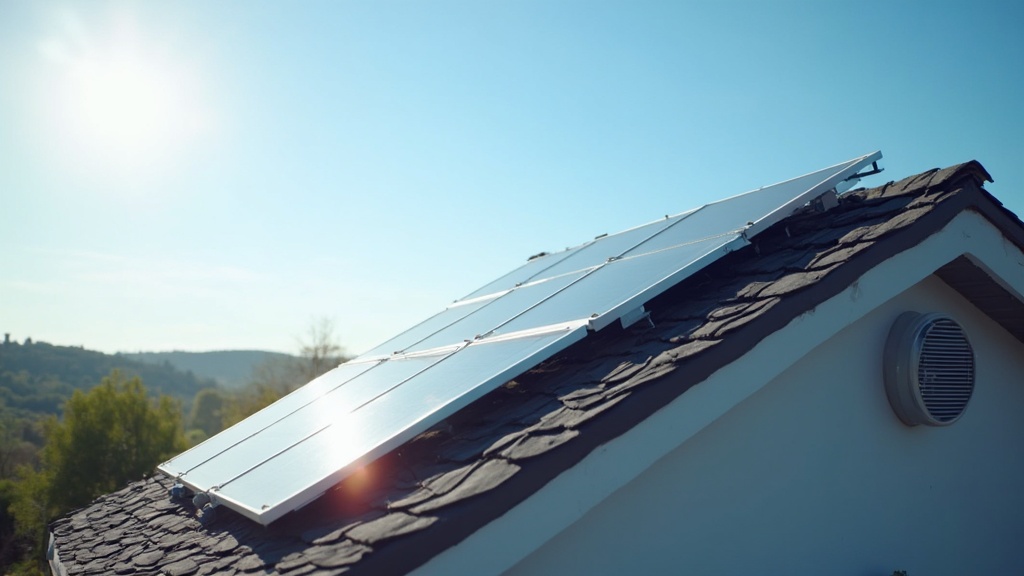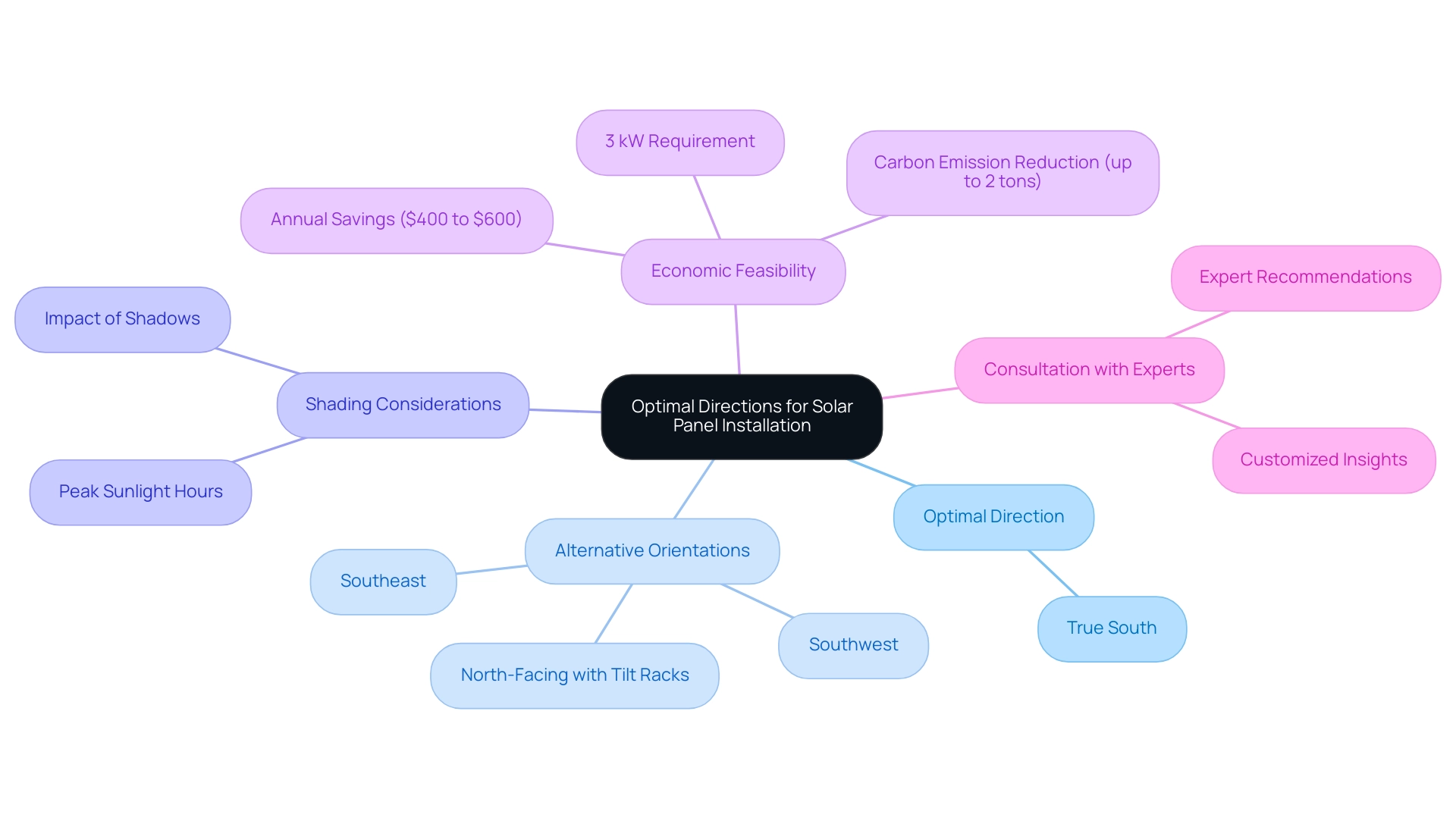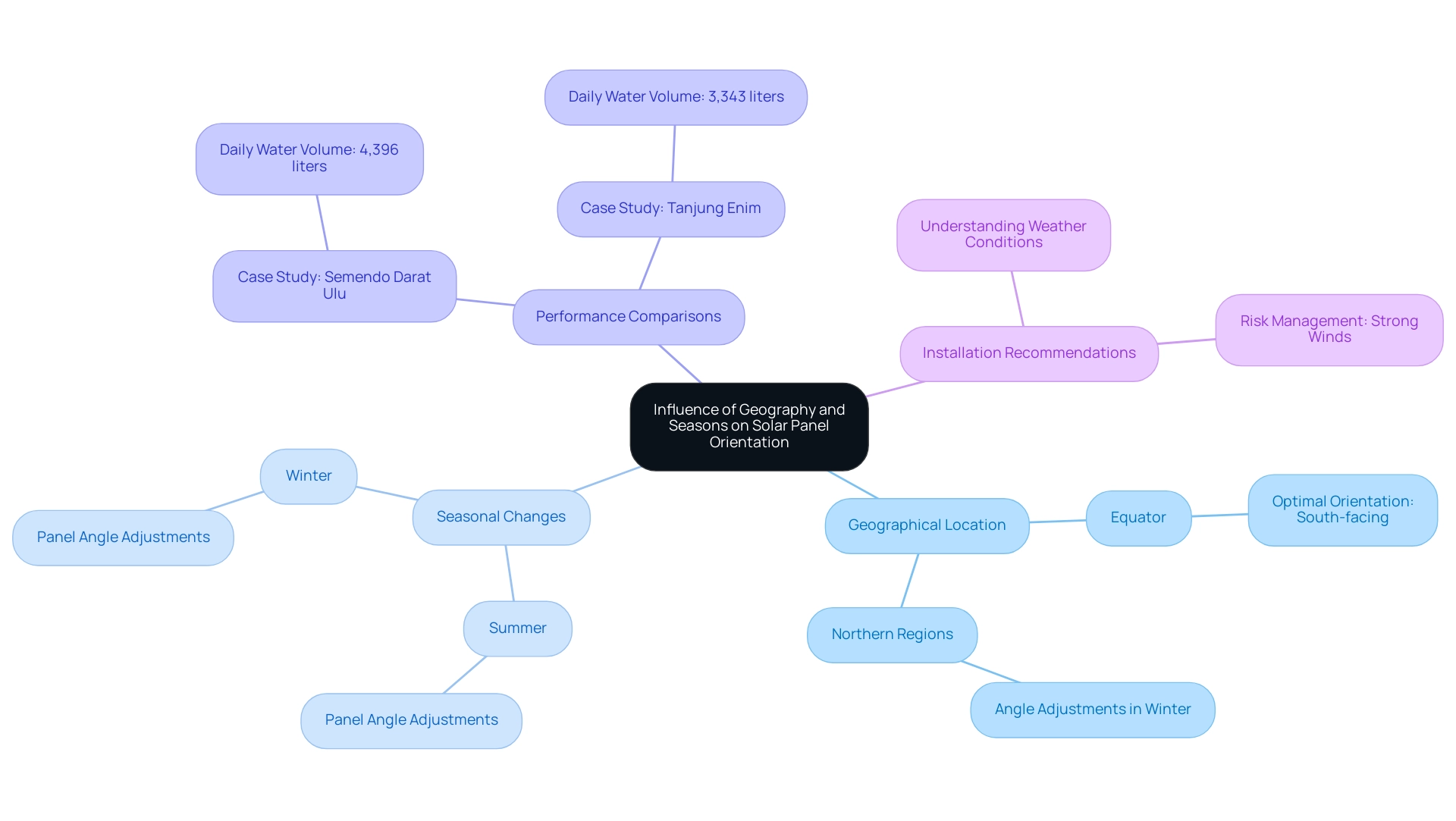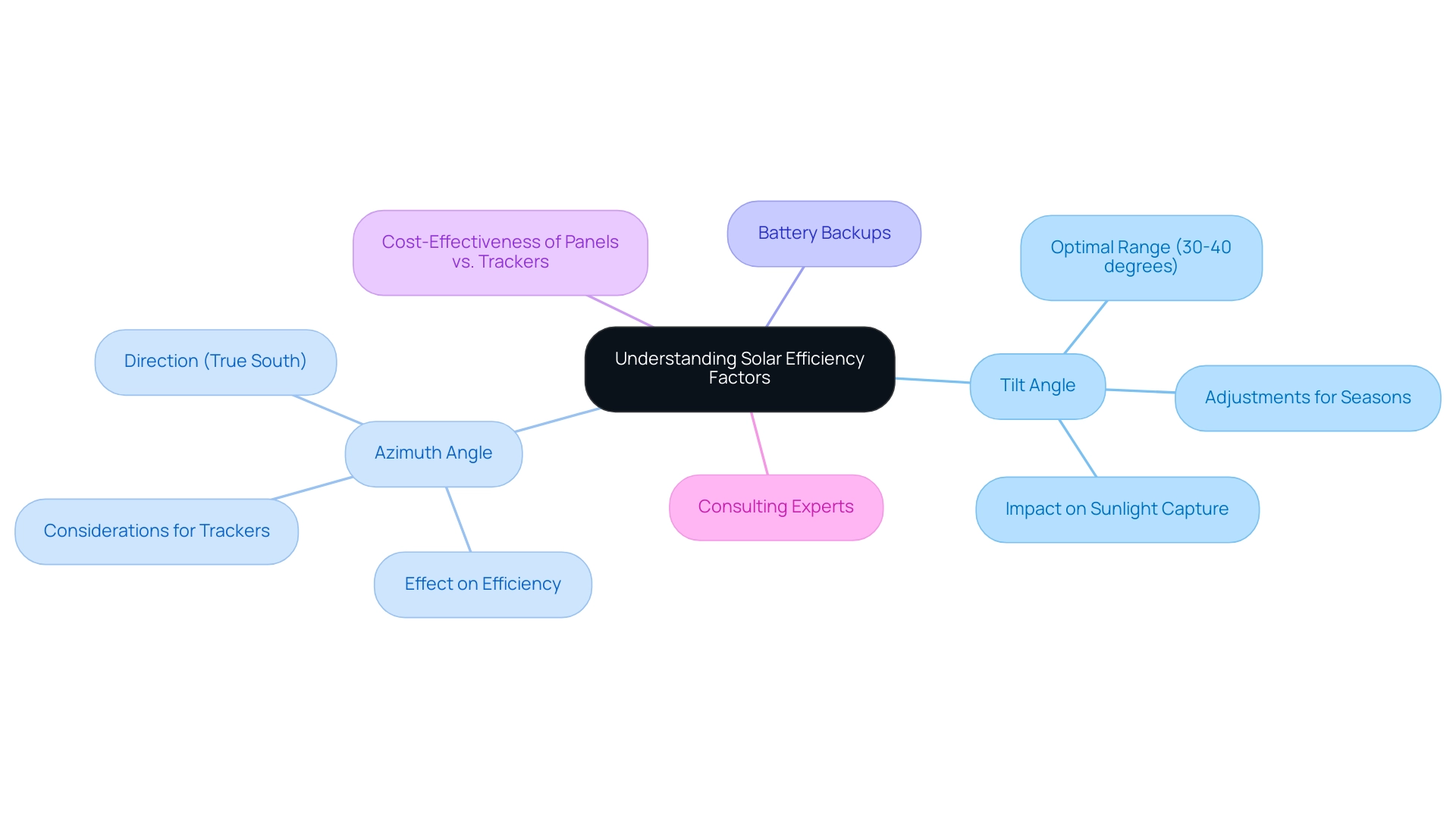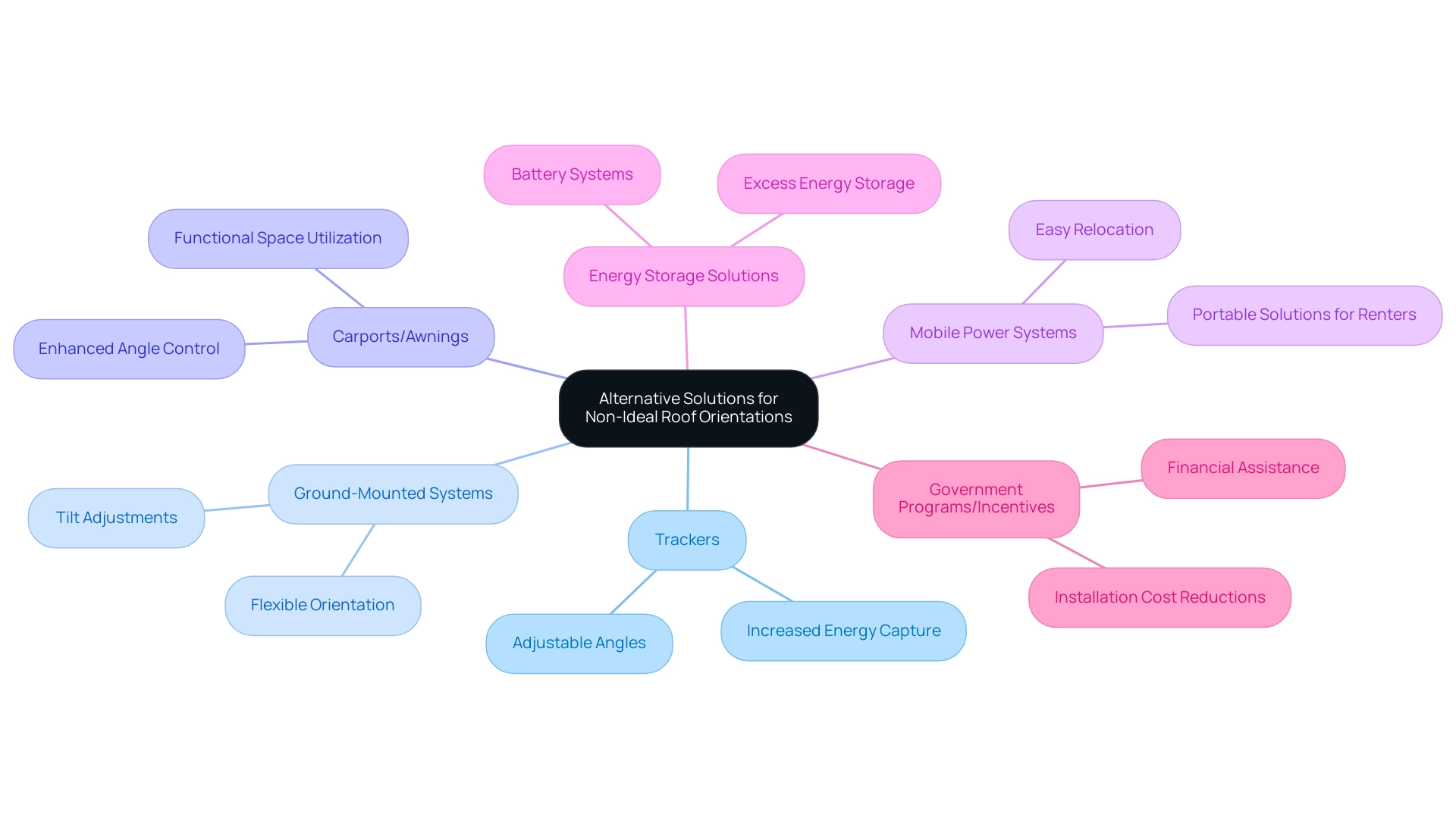Introduction
Navigating the world of solar energy can feel overwhelming, especially when it comes to optimizing the installation of solar panels. Homeowners are often left wondering about the best direction, angle, and setup to harness the sun’s power effectively. From understanding how geographical location and seasonal changes impact energy production to exploring alternative solutions for non-ideal roof orientations, there are numerous factors at play.
This article delves into the critical considerations for solar panel placement, providing insights that can help homeowners maximize their investment in renewable energy. With the right strategies, anyone can transform their property into a solar powerhouse, reducing energy costs while contributing to a more sustainable future.
Optimal Directions for Solar Panel Installation
To effectively utilize the sun’s power, homeowners in the northern hemisphere need to know which way to point solar panels, and the gold standard is to orient them to face true south. This optimal direction shows which way to point solar panels to maximize sunlight exposure throughout the day, leading to enhanced energy production and significant cost savings. For instance, at latitude 50°, the summer insolation is 5.1 kWh/m², which underscores the importance of proper orientation.
However, structures can still perform admirably when considering which way to point solar panels, especially if oriented southeast or southwest in areas with minimal shading from trees or buildings. As Bill Horbaly, President and CEO at Connected Technology, aptly puts it, ‘If all the other productive space is covered, sometimes it’s cost-effective to install tilt racks on a north-facing roof to keep solar arrays in the sunlight for longer.’ Additionally, EnergySage confirms that if your roof can accommodate at least 3 kW of photovoltaic energy, or about 8 panels, evaluating the economic feasibility of your installation is essential.
Taking into account your property’s unique layout is essential, as any structures that cast shadows during peak sunlight hours can greatly influence your system’s effectiveness and overall performance. Furthermore, it’s important to evaluate the thermal efficiency rating of your heating system, which indicates how effectively it converts sunlight into usable heat. High-efficiency systems can save homeowners between $400 to $600 annually on utility expenses, while also reducing greenhouse gas emissions by preventing up to 2 tons of carbon dioxide from entering the atmosphere each year.
Consulting a renewable resources expert can provide customized recommendations and insights on which way to point solar panels for your installations, ensuring you maximize your investment in sustainable solutions, which not only aids in lowering utility expenses but also supports a healthier planet.
Influence of Geography and Seasons on Solar Panel Orientation
The effectiveness of solar technology is greatly influenced by your geographical location and the seasonal changes that occur throughout the year. For instance, if you reside nearer to the equator, you’re likely enjoying abundant direct sunlight, making a south-facing orientation perfect for optimizing power capture. Conversely, if you live further north, adjusting the angle of your solar arrays slightly during the winter months can significantly enhance performance by knowing which way to point solar panels, as the sun hangs lower in the sky.
Seasonal variations can greatly affect power production; during summer, panels might need a different angle compared to winter to optimize efficiency. Comprehending how weather conditions influence your photovoltaic system is essential for utilizing renewable power efficiently. Experts emphasize that by understanding the effects of weather conditions on photovoltaic (PV) performance, we can harness sunlight energy more successfully and contribute to a more sustainable energy future.
A comparative study of heater performance in different climates emphasizes that areas such as Southern California, with its plentiful sunshine, can attain higher effectiveness than cloudier regions. For example, a case study in Semendo Darat Ulu showed the daily water volume pumped by the PV system was 4,396 liters—132% more than the 3,343 liters pumped in Tanjung Enim—illustrating performance variations based on geographical factors. Additionally, the case study titled ‘Impact and Performance Efficiency Analysis of Grid-Tied Solar Photovoltaic System’ highlights how adapting panel orientation according to seasonal patterns can lead to improved efficiency.
It’s also crucial to consider potential risks; very strong winds can damage energy systems and their mounting structures, which highlights the importance of careful installation and orientation based on local weather conditions. By dedicating time to understand the seasonal patterns in your region, particularly in areas such as Southern California, you can make informed choices about your installation. This knowledge will enable you to access the economic and environmental advantages of heating systems, including decreased utility costs and a smaller carbon footprint.
The Role of Tilt and Azimuth Angles in Solar Efficiency
The tilt angle of your solar devices refers to how steeply they’re positioned in relation to the ground. For homeowners keen on maximizing sunlight capture, understanding which way to point solar panels by aligning your tilt angle with your latitude is often the most effective approach. Research shows that a tilt angle ranging from 30 to 40 degrees usually produces remarkable outcomes, enabling your devices to capture sunlight efficiently while lowering utility expenses and improving self-sufficiency.
Notably, differences in optimal tilt angle calculations from literature are generally lower than 1%, underscoring the reliability of these recommendations. Additionally, the azimuth angle, which indicates which way to point solar panels, should ideally face as close to true south as possible for optimal efficiency. It’s also important to consider that the effectiveness of these angles can fluctuate due to seasonal weather changes, emphasizing the need for regular adjustments to maintain energy production and promote sustainability.
As solar expert Life aptly states, ‘You have the roof you have. Load it up, start producing and don’t let perfect be the enemy of good (or great).’ Furthermore, it’s worth mentioning that while trackers can theoretically enhance production by adjusting to face the sun, they are often not cost-effective for residential systems.
For most homeowners, adding extra panels is a more economical solution than investing in trackers, which may not provide sufficient additional output to justify their expense. It’s crucial to contemplate battery backups for dependable power during outages and severe weather conditions, ensuring your home stays powered even when the grid fails. Consulting with a renewable power expert can offer personalized insights customized to your home’s specific requirements.
For additional comprehension, refer to extensive guides or user manuals that explain photovoltaic system functionality and maintenance. Remember, when it relates to sunlight power, strategic placement of modules can significantly impact your autonomy and sustainability initiatives! Take the first step towards a more sustainable life today by getting your free personalized estimate.
Alternative Solutions for Non-Ideal Roof Orientations
If your roof alignment isn’t optimal for photovoltaic systems, you might need to consider which way to point solar panels! There are numerous options to assist you in optimizing which way to point solar panels to enhance your renewable power potential. One excellent choice is trackers that adjust the angle of your devices throughout the day, which way to point solar panels, to follow the sun’s trajectory and capture more energy.
For instance, during spring, the ideal angle for photovoltaic systems varies from 24 to 35 degrees, rendering trackers especially efficient. Ground-mounted systems also provide excellent flexibility for orientation and tilt adjustments, including which way to point solar panels, that aren’t limited by your roof’s design. Additionally, consider placing structures on carports or awnings, which way to point solar panels can enhance angle control while also serving as a functional space.
For those unable to install rooftop energy panels, mobile power systems present a portable solution, offering savings on electricity without impacting your property. It’s also important to explore roofing enhancements that can improve your installation, including understanding which way to point solar panels to ensure your home is well-equipped to capture sunlight effectively. Energy storage solutions, such as battery systems, can further optimize your energy use, allowing you to store excess energy generated during the day for use at night.
Additionally, remember to look for government programs or incentives offered in Southern California that can assist in reducing the expenses of installation and enhancements. To find the optimal energy solution customized for your specific circumstances, consulting with an installation expert is always a prudent step. As Powercore Electric highlights, enhancing your photovoltaic system efficiency is crucial—> Reach out to us today for a complimentary roof assessment and begin saving more with clean energy <.
With the right guidance and innovative solutions, you can harness the sun’s power, no matter what your roof looks like!
Key Considerations for Choosing Solar Panel Orientation
When placing your solar arrays, it’s essential to consider which way to point solar panels along with several other important factors to maximize your investment. First, consider the design and pitch of your roof—these elements can significantly impact the angle at which sunlight hits your panels. Local climate conditions, as highlighted in case studies from Southern California and the Pacific Northwest, play a crucial role in determining energy production throughout the year.
For instance, in Southern California, heating units frequently operate at their best because of the area’s plentiful sunlight, with research indicating that systems can reach as much as 90% of their designated effectiveness. In contrast, regions with fluctuating climates, such as the Pacific Northwest, may experience performance decrease to around 60-70% due to heightened cloud cover and precipitation.
Another key aspect to consider is possible shading from nearby trees, buildings, or even your own residence. Did you know that shading can significantly diminish your solar energy system performance? For example, surfaces oriented north can lose as much as 30% of their effectiveness!
This is why it’s best to determine which way to point solar panels by aiming for a south-facing orientation whenever possible, as studies indicate that performance decreases about 15% for every 90 degrees you stray from this direction. A case study highlights that understanding which way to point solar panels is crucial, as panels directed away from south can encounter substantial reductions in performance, reinforcing the significance of optimal positioning for maximizing power output.
As Long Beach tenants, you may encounter distinct challenges such as limited roof space or restrictions from landlords on installation. Therefore, it’s important to consider whether you plan to expand your energy system in the future. Planning for that potential growth now can help you avoid costly adjustments later on.
As highlighted by specialists, assessing the power conversion effectiveness of different power transformations is essential when making these choices, particularly regarding the distinct climate conditions in your region.
Ultimately, consulting with a renewable professional can offer customized guidance to suit your specific circumstances. They can guide you through these considerations, ensuring your panel installation is optimized for your energy needs and the specific characteristics of your property. Remember, the right placement can mean the difference between a good solar setup and a great one!
Conclusion
Maximizing the potential of solar panels involves careful consideration of various factors, including orientation, tilt, and local geography. By positioning panels to face true south, homeowners can significantly enhance energy production and reduce utility costs. Seasonal adjustments to tilt angles can further optimize performance, particularly in regions where sunlight varies throughout the year. Understanding the influence of local climate and potential shading is crucial for maintaining efficiency and making the most of the investment in solar energy.
For those with non-ideal roof orientations, alternative solutions such as:
- Solar trackers
- Ground-mounted systems
can provide flexibility and increased energy capture. Exploring options like:
- Battery storage
- Government incentives
can also enhance the benefits of solar installations. Ultimately, consulting with a solar professional is key to navigating these considerations and tailoring the setup to individual needs.
Embracing solar energy not only leads to substantial cost savings but also contributes to a more sustainable future. With the right knowledge and strategies, homeowners can transform their properties into efficient solar energy producers, making a positive impact on their finances and the environment alike. Now is the perfect time to take action and harness the sun’s power, ensuring a brighter and more sustainable tomorrow.


